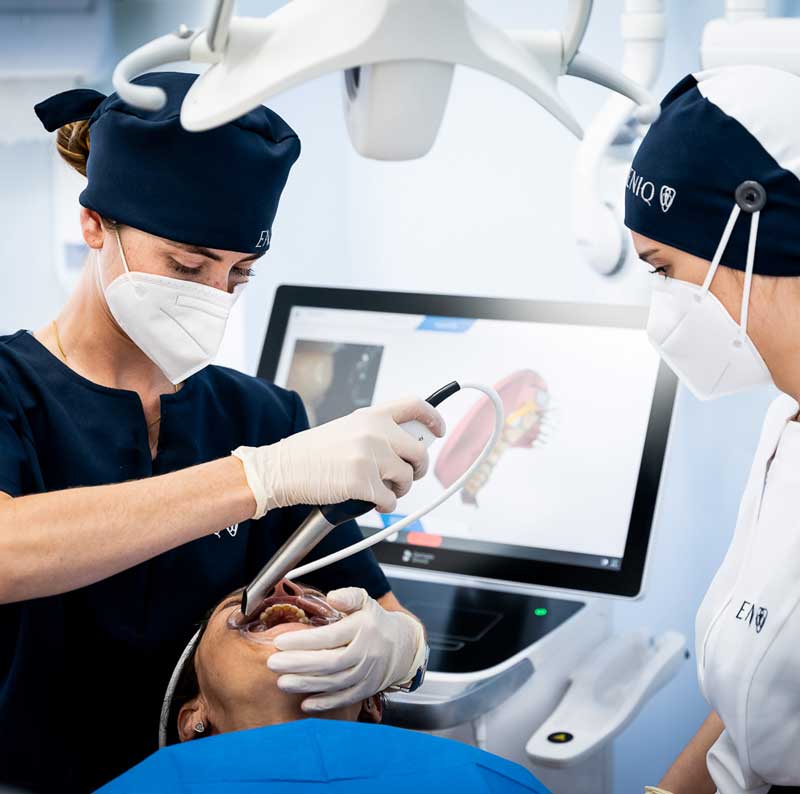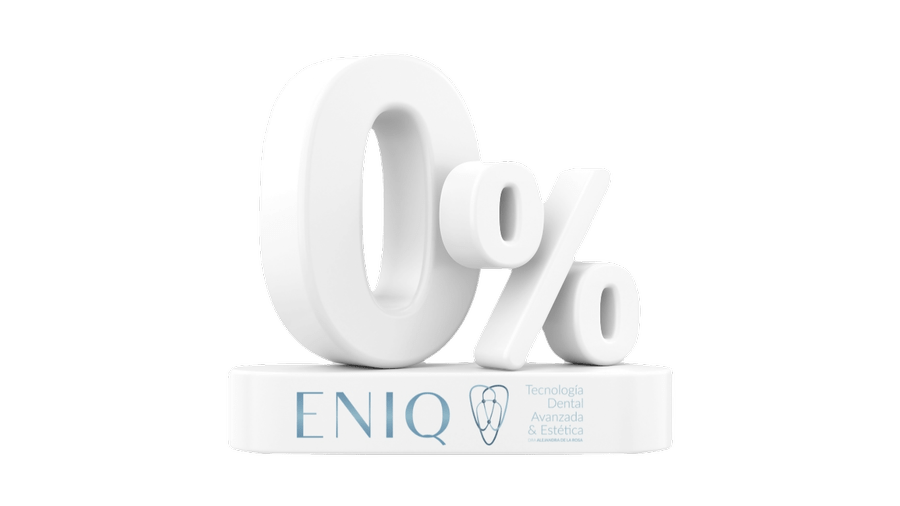

Occlusal Adjustment
Advanced technology and precise techniques to correct your bite.
What is an Occlusal Adjustment?
Occlusal adjustment, also known as occlusal adjustment, is a dental procedure performed to correct and balance the bite or the way the upper and lower teeth fit together. The main goal of occlusal adjustment is to achieve a balanced and stable occlusion, that is, a bite in which the teeth contact properly and evenly during different oral functions, such as chewing and speaking.
During the occlusal adjustment, the dentist will assess the patient's occlusion through a clinical examination and, in some cases, the use of occlusal records and bite analysis. They will identify premature contact points, areas of occlusal interference, and imbalances in the distribution of occlusal load. These irregularities can cause problems such as excessive dental wear, pain in the temporomandibular joint (TMJ), difficulty chewing, headaches, and other symptoms related to incorrect bite.
The dentist will use different techniques and tools to perform the occlusal adjustment, such as selective grinding of high contact points or occlusal interferences, correction of the tilt or height of the teeth, and redistribution of the occlusal load to achieve a balanced occlusion.
What is the Selective Grinding Procedure Like?
Selective grinding, also known as selective wear, is a dental procedure used in occlusal adjustment to correct high contact points or occlusal interferences on the teeth. The main goal of selective grinding is to balance the occlusion and achieve a uniform distribution of occlusal load.
The selective grinding procedure generally follows these steps:
- Occlusion Assessment: The dentist performs a detailed evaluation of the patient's occlusion to identify high contact points and occlusal interferences. This can be done through a clinical examination, occlusal records, and bite analysis.
- Determining Areas for Grinding: Based on the occlusion assessment, the dentist determines the specific areas that require selective grinding. These areas may be where contact points are too high, where there are occlusal interferences, or where the occlusal load is unbalanced.
- Grinding High Contact Points: Using appropriate dental instruments, such as burs or diamond stones, the dentist performs selective grinding on high contact points. This involves removing small amounts of dental material from the occlusal surfaces of the teeth to reduce high contact points and achieve a more balanced occlusion.
- Verification and Adjustment: After selective grinding, the dentist re-evaluates the occlusion to assess balance and occlusal load distribution. If necessary, additional adjustments are made to ensure proper occlusion.
- Follow-up: After the selective grinding procedure, a follow-up phase may be recommended to evaluate the occlusion's response and make further adjustments if necessary.
It is important to highlight that selective grinding should be performed by an experienced and trained dentist in this technique to avoid over-removal of dental tissue and ensure optimal results. Each case is unique, and the approach to selective grinding may vary according to the individual needs of the patient.
Benefits
What are the advantages and disadvantages of selective carving?
Occlusal adjustment, also known as occlusal equilibration, is a dental procedure aimed at correcting and balancing the way the upper and lower teeth fit together. It focuses on achieving a balanced and stable occlusion, which directly affects oral function during activities such as chewing and speaking.

Digital anesthesia offers several advantages compared to traditional anesthesia:
- Improved Function: By correcting occlusion, the ability to chew and speak efficiently is improved.
- Symptom Relief: Occlusal adjustment can alleviate pain in the TMJ, headaches, and other symptoms associated with incorrect biting.
- Teeth Protection: By balancing the occlusal load, excessive wear on the teeth is reduced, and the risk of dental fractures is avoided.
- Long-term Stability: A proper occlusal adjustment provides a stable occlusion, which helps prevent future problems related to incorrect biting.
It's important to note that the availability of digital anesthesia may vary depending on the dental office and geographic location. If you are interested in this type of anesthesia, I would recommend talking to your dentist to determine if they offer this service and if it is appropriate for your specific case.
Contraindications or disadvantages: NONE
It is important to highlight that occlusal adjustment must be performed by an experienced and trained dentist in this technique to ensure optimal results and avoid potential complications. Each case is unique, and the approach to occlusal adjustment may vary according to the individual needs of the patient.
+75%
¿Cuál es el porcentaje de éxito del ajuste de oclusión?
Determining an exact percentage of success for occlusal adjustment is difficult, as it can depend on a variety of factors, including the skill and experience of the dentist, the complexity of the case, patient collaboration, and the presence of underlying conditions such as bruxism or temporomandibular joint disorders (TMJ). However, it can be said that the goal of occlusal adjustment is to achieve a balanced and functional dental occlusion that provides an even distribution of chewing forces.
When occlusal adjustment is performed properly, it can have a significant impact on the health and well-being of the patient, reducing the risk of issues such as headaches, jaw pain, abnormal dental wear, dental sensitivity, and other temporomandibular disorders.
The success of occlusal adjustment can be assessed based on the elimination of occlusal interference points, improvement in the distribution of chewing forces, reduction of symptoms associated with poor occlusion, and improvement in the stability and function of the temporomandibular joint.
It is important to note that the long-term success of occlusal adjustment may also depend on regular follow-up by both the patient and the dentist, as well as the performance of additional adjustments if necessary. Additionally, in some cases, it may be necessary to combine occlusal adjustment with other dental treatments or therapies to achieve optimal results.
Overall, occlusal adjustment can be highly successful when performed carefully and accurately, with a thorough evaluation of occlusion and individualized attention to the specific needs of each patient. However, success may vary depending on individual circumstances, and it is important to discuss expectations and risks with a qualified dental professional before undergoing any occlusal adjustment procedure.
What are the benefits of undergoing occlusal adjustment at ENIQ?
Undergoing occlusal adjustment with technology can offer several benefits compared to traditional methods. Some of these benefits include:
- Precision and accuracy: Advanced technology, such as digital dentistry and intraoral scanning systems, allows for precise and detailed measurement of occlusion. This helps to more accurately identify high contact points and occlusal interferences, facilitating a more precise adjustment.
- Real-time visualization: With the help of technologies like intraoral scanners and 3D visualization programs, dentists and patients can see in real time the image of the occlusion and the changes made during the adjustment. This allows for better understanding and patient involvement in the treatment process.
- Efficiency and speed: The use of technology can speed up the occlusal adjustment process, as it eliminates the need for traditional impressions and prolonged manual adjustments. Digital systems allow for rapid scanning and instant visualization of occlusion, reducing the time needed to complete the procedure.
- Less discomfort for the patient: The use of modern technology can minimize the need for invasive procedures and reduce discomfort for the patient. For example, intraoral scanners eliminate the need for impressions with uncomfortable materials, and precise adjustments minimize the need for additional wear.
- Predictable and aesthetic results: Advanced technology allows for virtual planning and simulation of changes in occlusion before any adjustment is made. This allows for foreseeing and predicting the final results, leading to a more predictable and aesthetic treatment.
It's important to note that the choice to use technology in occlusal adjustment depends on the availability of equipment and the dentist's training. Not all cases will require the use of technology, and the decision should be based on the individual assessment of each patient.
What is the price of an occlusal adjustment?

- Financing: Up to 24 months without interest. Up to 60 months with preferential conditions.
- Payment breakdown: Pay monthly in comfortable installments for the treatment.
- Early payment discount: Paying the entire treatment at the start.
- Multiple payment options: Bank direct debit, credit card, cash, transfer, Apple Pay, Google Pay, and Bizum.
Occlusal Adjustment
Dental Adjustment
*subject to specialist evaluation
Experience the comfort of a balanced smile. Our occlusal adjustment service offers you dental harmony and well-being. Recover the balance of your bite from 250€.
-
All-inclusive
-
Interest-free financing
Frequently Asked Questions
Do you have more questions about occlusal adjustment?
Two appointments are required; in one appointment, photos and records are taken. In another appointment, selective carving is carried out, without any pain or anesthesia.
Generally, no special care is required. It is recommended to follow good dental hygiene and attend regular check-ups with the dentist to ensure that the bite remains balanced.
No, this procedure is performed painlessly, without the need for anesthesia. It is carried out with precision to improve the patient's comfort while chewing and speaking.
